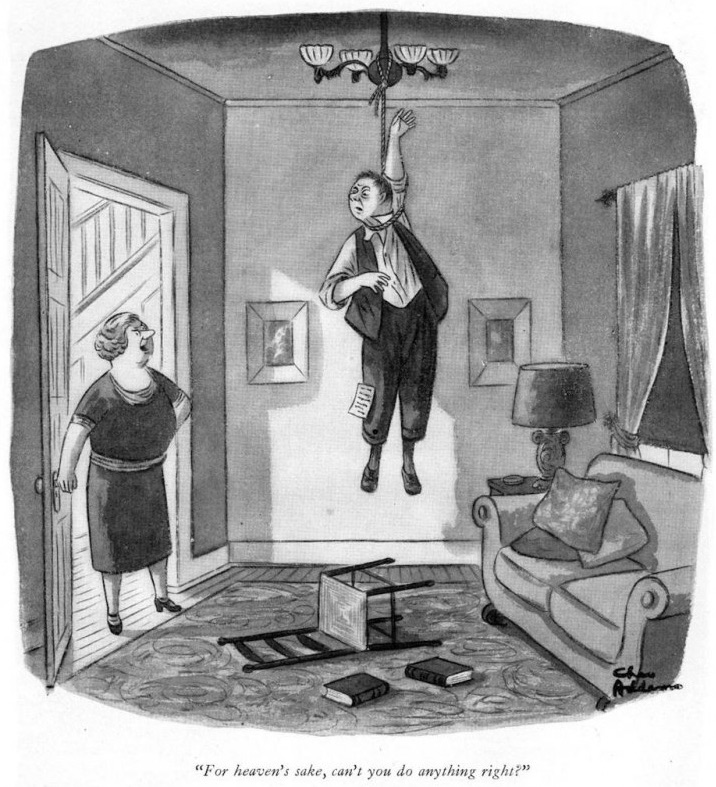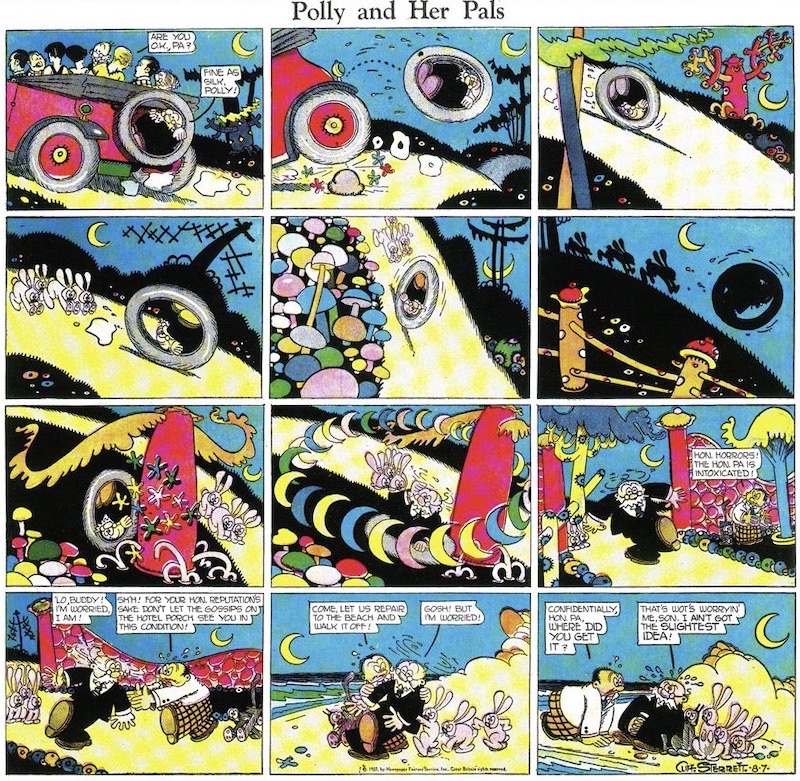Binky Brown Meets the Holy Virgin Mary (1972) by Justin Green
REVIEW BY CHARLES HATFIELD:
Binky Brown is the longest, and most profound, piece of sustained narrative to emerge from underground comix. A shocking, riotous, and absurdly moving memoir of Catholic guilt,
Binky offers both harrowing psychological insight (into the condition since labeled Obsessive-Compulsive Disorder) and stunning graphics, the latter courtesy of Green's eclectic vocabulary and dead-on parodic instincts. Rife with pointed symbolism, the pages of
Binky riff deliriously on Durer,
Crumb,
Chester Gould, Superman comics, and scores of other sources, with a superb technique that at times approaches engraving-like texture. The story begins lucidly enough, clearly dividing fantasy from reality, but eventually its finely observed realism collides and merges with antic, dreamlike symbolism. Green's restless, protean style demonstrates that realistic, personal comics need not be tethered to any literal-minded notion of illustrative realism - a lesson not lost on the many cartoonists who have been influenced by
Binky's blend of autobiography and graphic fantasy.
Since being published by Last Gasp in 1972, Binky has inspired seminal first-person comics by such cartoonists as Crumb, Kaminsky-Crumb and Spiegelman. On its own terms, it remains an extraordinary achievement: a surreal, bleakly humourous mixture of anti-Catholic polemic and scourging confession. Over its 40 pages, Green uncorks his psyche, examining in harrowing detail the intersection of Catholic doctrine and his own neurotic, guilt-driven personality. Religious fervour and psychological obsession feed into each other, turning "Binky" (Green) into a fretfulzealot whose life is all but consumed by radical self-doubt. Binky is devoted to (and exhausted by) constant checking, double-checking, and triple-checking to make sure no sins are committed - or at least none left unatoned.
Binky's obsession involves imaginary rays of light emanating from his penis, his limbs, and even the material objects around him. These rays must be prevented at all costs from sticking representations (visual or verbal) of the Catholic Church, and in particular the Virgin Mary. This is of course an artist's conceit: the rays threaten to converge on the Virgin in much the same way that, in classical perspective, imaginary lines connect parallel objects to a common vanishing point. The world of Binky is one of grid-like precision, a landscape crisscrossed by invisible vectors of sin. Green's artwork both reflects and resists this linearity, with a riot of mixed forms: rigid and angular versus rounded and fleshy. Indeed, his carefully worked pages enact a struggle between hard-edged asceticism (in his words, "order, uniformity, rigidity, and obedience") and indulgent sensuality. Binky crackles with this tension.
What makes Binky so bold and effective is the extravagance of Green's visual metaphors. While he faithfully captures the cultural landscape of his formative years, Green also deploys a series of bizarre symbols that capture young Binky's inner landscape just as precisely. At first such conceits are confined to young Binky's dreams and fantasies, but they gradually assert themselves through passages of Green's anti-Catholic argument (eg parochial school students are brainwashed and turned into marionettes, replete with strings). Eventually, elements of fantasy begin to intrude on Binky's everyday life: visual metaphors multiply as Binky becomes increasingly dominated by his obsessive guilt. As Binky's world becomes more and more pinched and cloistral, Green's artwork breaks free, employing a huge arsenal of design conceits, graphic devices and rendering styles. Shifting layouts, labels, signboards and mock-scholarly annotations run rampant, while open, white panels contrast with zip-a-tone grays and densely cross-hatched backgrounds. Those expecting a documentary realism, to authenticate Green's polemic, will be perplexed by his anarchic visual imagination.
Reflexive playfulness characterises Binky from beginning to end. For example, the penultimate panel finds the hero, having spurned Catholicism, eyeing an overdue stack of library books: First Catechism, Perspective and Fun With a Pencil. This single image underscores not only Green's relationship to the Church, but also his grasp of classical art and his dedication to drawing. Even more: in the background, a cartoon by R. Crumb hints at another source of inspiration. Metonymically, Crumb (himself a lapsed Catholic) stands in for the underground comix, then in their heyday, which liberated Green artistically, inspiring him to set forth his own story in comics form.
Of course, the "pencil" in the third title, Fun With a Pencil, also substitutes metamorphic ally for the feared penis, the original source of the rays which have so monopolised Binky's imagination. Green employs this metaphoric likeness from the outset: the frontispiece is a grimly hilarious image of the naked artist, hands bound behind his back, a pen gripped in his mouth, with a long scythe-like blade poised dangerously close to his groin. Both artist's tool and endangered phallus are impious and inadmissible (Green dips his pen in God's blood; his very word balloon bears a crown of thorns). Here Green, in a confession to his readers, admits that Binky represents an effort to "purge" himself of a "compulsive neurosis." Begging indulgence for focusing on "the petty conflict in [his] crotch", the cartoonist suggests that portraying his neurosis in "easy-to-understand comic-book format" may actually help others similarly afflicted, and thus intervene in a larger social problemm: "If all the neurotics were tied together we would entwine the globe many times over in a vast chain of human suffering."
With this, Green hits on one of the great virtues of autobiography: its ability to expose private trauma as a public issue, and to focus our attention on the relationship between self and society. It is this social dimension which lifts Binky above mere calculated outrage and makes it insightful, provocative, and, finally, wonderfully moving.
REVIEW BY ART SPIEGELMAN:
It' s no small thing to invent a genre. I readily confess that without his work there could have been no Maus.
REVIEW BY ROBERT CRUMB:
Justin Green - he's out of his mind. I love every stroke of his nervous pen, every tortured scratch he ever scrawled. He was among the top storytelling artists of the first wave of “underground” comics, a darkly humorous social commentator, and the FIRST, absolutely the FIRST EVER cartoonist to draw highly personal autobiographical comics. Binky Brown started many other cartoonists along the same path, myself included. Few have come close to him in revealing themselves in this medium. For me, there’s nothing more enjoyable than the confessions of a tortured soul, if the story is
well-told, entertaining, honest, and then funny on top of it. If that’s what you’re looking for, and if you like it in comic book form, Justin Green is
the first and the best!
REVIEW BY CHRIS WARE:
Thank God that it’s getting harder to imagine a time when comics were a lowly commercial hack-job for illustrators who couldn’t find work anywhere else. It’s even harder to imagine the effect of a comic book in such a cultural climate by an artist who tore himself to pieces right on the page, trying to get at the core of something that was literally consuming him, but this is what Justin Green did. With Binky Brown, comics went practically overnight from being an artform that saw from the outside in to one that sees from the inside out. His internal struggle can practically be felt in the drawings themselves, the style sometimes changing from panel to panel - sometimes even within the panels themselves - all in an effort to simply
arrive at The Truth. Comics wouldn’t be what they are today without this book, and this new edition places it in its proper place in the comics literary canon. Thank God for Binky Brown. And thank God for Justin Green.
FURTHER READING:






















